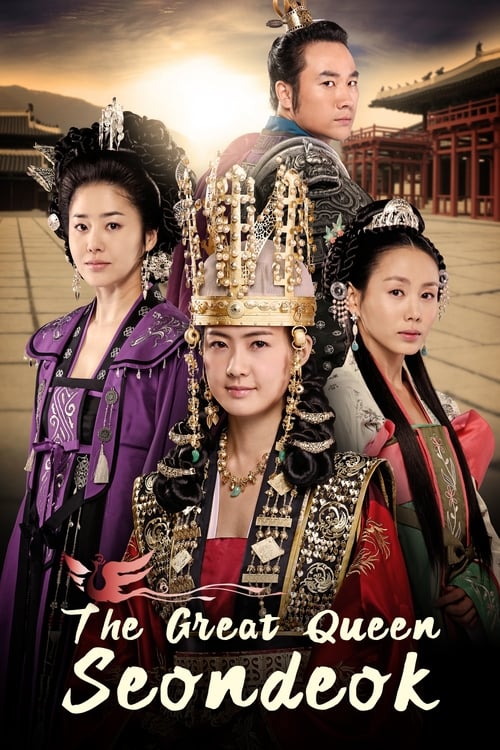
Ask Your Own Question
What is the plot?
In the kingdom of Silla, the story begins with the birth of Princess Seondeok, the daughter of King Jinpyeong. Her birth is marked by a prophecy that she will become a great queen. However, her mother, Queen Maya, dies shortly after giving birth, leaving Seondeok to grow up under the care of her father and the watchful eyes of the court. As a child, Seondeok shows intelligence and a strong will, often clashing with the traditional expectations of women in her society.
As Seondeok matures, she becomes aware of the political tensions within Silla, particularly the rivalry between her family and the powerful Kim clan. The Kim clan, led by the ambitious Kim Yu-sin, seeks to control the throne and eliminate any threats to their power. Seondeok's older sister, Princess Chonmyung, is also a key figure, as she is seen as a potential queen. However, Chonmyung is more focused on her love for Kim Yu-sin, which complicates the political landscape.
The plot thickens when Queen Maya's spirit appears to Seondeok, guiding her and revealing the importance of her destiny. Seondeok's relationship with her father becomes strained as King Jinpyeong struggles to accept her as a potential ruler. Meanwhile, the Kim clan's machinations intensify, leading to a series of political maneuvers and betrayals. Seondeok's intelligence and strategic thinking begin to shine as she navigates the treacherous waters of court politics.
As tensions rise, Seondeok's sister Chonmyung is betrothed to Kim Yu-sin, but their love is tested by the political ambitions of their families. Seondeok, feeling the weight of her destiny, decides to take matters into her own hands. She begins to gather allies, including the loyal and skilled warrior, Kim Yu-sin, who becomes a key figure in her plans. Their relationship evolves from one of rivalry to mutual respect and partnership.
The story takes a dramatic turn when a rival kingdom, Baekje, threatens Silla's stability. Seondeok, recognizing the need for unity, proposes a military alliance with Kim Yu-sin and the Kim clan to fend off the external threat. This decision is met with resistance from some factions within the court, but Seondeok's determination and vision for a united Silla begin to sway opinions.
As the war with Baekje escalates, Seondeok proves her mettle on the battlefield, showcasing her strategic prowess. She leads her forces alongside Kim Yu-sin, and their combined efforts result in a significant victory for Silla. However, the cost of war weighs heavily on Seondeok, as she witnesses the loss of life and the toll it takes on her people.
In the aftermath of the battle, Seondeok's leadership is recognized, and she begins to gain the support of the people. However, the internal strife within the court continues, as factions vie for power. Seondeok faces betrayal from those she once considered allies, leading to a series of confrontations that test her resolve and leadership.
As the political landscape shifts, Seondeok's relationship with Kim Yu-sin deepens, but their love is fraught with challenges. They must navigate the complexities of their respective loyalties while striving for a common goal: the unification and prosperity of Silla. Seondeok's character evolves as she embraces her role as a leader, balancing her personal desires with her responsibilities to her kingdom.
The climax of the story occurs when Seondeok is finally crowned queen after a series of trials and tribulations. Her ascension to the throne is met with both celebration and opposition, as the Kim clan and other factions within the court continue to plot against her. Seondeok's reign is marked by her efforts to implement reforms and strengthen Silla, but she must constantly defend her position against those who seek to undermine her authority.
In the final episodes, Seondeok faces her greatest challenge when a coup is staged against her. Betrayed by those closest to her, she must rally her loyal supporters and confront the conspirators head-on. The confrontation is intense, with battles fought both in the court and on the battlefield. Seondeok's strategic mind and unwavering spirit shine as she outmaneuvers her enemies, ultimately securing her position as queen.
The series concludes with Seondeok solidifying her legacy as a powerful and wise ruler. She reflects on her journey, the sacrifices made, and the challenges overcome. Her reign marks a new era for Silla, one characterized by strength, unity, and the promise of a brighter future. Seondeok's story becomes a testament to her resilience and determination, leaving an indelible mark on the history of her kingdom.
What is the ending?
In the ending of "The Great Queen Seondeok," Queen Seondeok faces the culmination of her struggles for power and peace in Silla. After a series of betrayals and conflicts, she ultimately sacrifices her personal happiness for the greater good of her kingdom. The series concludes with her legacy being solidified as a wise and strong ruler, while her adversaries meet their fates, and the future of Silla is left in the hands of her chosen successor.
As the final episodes unfold, the tension in Silla reaches a boiling point. Queen Seondeok, portrayed with a mix of strength and vulnerability, stands resolute in her palace, contemplating the sacrifices she has made. The weight of her crown feels heavier than ever as she reflects on the betrayals she has faced, particularly from those she once considered allies.
In a pivotal scene, the queen confronts her long-time rival, Lady Mishil, who has been a constant thorn in her side. The two women engage in a fierce battle of wits and wills, each representing different visions for Silla's future. Lady Mishil, driven by her ambition and desire for power, attempts to manipulate the court against Seondeok. However, the queen's determination shines through as she rallies her loyal supporters, including the brave warrior Kim Yu-sin, who has been a steadfast ally throughout her reign.
As the conflict escalates, the stakes become personal. Seondeok's closest confidant, the wise monk Eun-jeong, urges her to consider the cost of her ambition. In a heart-wrenching moment, Seondeok realizes that her quest for peace may require her to make the ultimate sacrifice. She decides to confront Lady Mishil one last time, leading to a dramatic showdown that culminates in a tragic yet necessary resolution.
In the final confrontation, Seondeok and Mishil face off in a tense standoff. The palace is filled with tension as the court watches, holding their breath. Seondeok, embodying the spirit of a true leader, stands firm against Mishil's manipulations. In a moment of desperation, Mishil attempts to strike a fatal blow, but Seondeok's quick thinking and bravery turn the tide. The confrontation ends with Mishil's downfall, as her own schemes backfire, leading to her demise.
With Lady Mishil defeated, Seondeok's victory is bittersweet. She stands alone in the palace, the weight of her decisions heavy on her heart. The emotional toll of her journey is evident as she gazes out over the kingdom she has fought so hard to protect. In her final moments, she reflects on the sacrifices made by those around her, including her loyal friend Kim Yu-sin, who has fought valiantly by her side but has also suffered great losses.
As the series draws to a close, Seondeok appoints her successor, ensuring that her vision for a united and prosperous Silla will continue. She chooses a young and capable leader, symbolizing hope for the future. The final scenes depict the kingdom beginning to heal, with the people rallying around their queen's legacy.
In the closing moments, Seondeok stands on a hill overlooking the land, a serene expression on her face. She has become a symbol of strength and resilience, embodying the spirit of Silla. The camera pans out, showing the vast landscape of the kingdom, now at peace, as the sun sets on her reign. The series ends with a sense of closure, highlighting the enduring impact of Seondeok's leadership and the sacrifices made for the greater good.
In summary, Queen Seondeok emerges as a powerful and wise ruler, having faced her adversaries and made difficult choices for the sake of her kingdom. Lady Mishil's ambition leads to her downfall, while Kim Yu-sin remains a loyal figure, supporting Seondeok's legacy. The fate of Silla is secured, leaving a lasting impression of hope and resilience.
Is there a post-credit scene?
The Great Queen Seondeok does not have a post-credit scene. The series concludes with a powerful and emotional finale that wraps up the main storylines and character arcs. The final episodes focus on Queen Seondeok's legacy, her struggles, and the impact of her reign on the Silla kingdom. The ending emphasizes themes of sacrifice, leadership, and the enduring strength of the queen, leaving viewers with a sense of closure regarding her journey and the future of Silla.
What are the key events that lead to Queen Seondeok's rise to power?
Queen Seondeok's rise to power is marked by several key events. Initially, she faces opposition from her half-brother, Kim Chunchu, who is also vying for the throne. After the death of their father, King Jinpyeong, the political landscape becomes tumultuous. Seondeok's intelligence and strategic mind come into play as she navigates court intrigues, forming alliances with influential figures like the monk, Jinpyo, and the warrior, Kim Yushin. Her ability to foresee the future and her deep understanding of the political dynamics of Silla help her to outmaneuver her rivals, ultimately leading to her coronation as the first female ruler of Silla.
How does the relationship between Queen Seondeok and Kim Yushin develop throughout the series?
The relationship between Queen Seondeok and Kim Yushin evolves significantly throughout the series. Initially, Yushin is a loyal warrior who serves Seondeok's family, but as they face numerous challenges together, a deep bond forms between them. Yushin admires Seondeok's intelligence and strength, while she respects his bravery and loyalty. Their relationship is tested by political pressures and personal sacrifices, particularly when Yushin is torn between his duty to the crown and his feelings for Seondeok. As they confront external threats, their partnership becomes a cornerstone of Silla's strength, culminating in a profound mutual respect and understanding.
What role does the character of Mishil play in the story, and how does she oppose Queen Seondeok?
Mishil serves as one of the primary antagonists in 'The Great Queen Seondeok.' A powerful and cunning noblewoman, she embodies the traditional patriarchal values of Silla while simultaneously wielding significant influence. Mishil opposes Queen Seondeok at every turn, viewing her as a threat to her own ambitions. She employs manipulation, espionage, and even assassination attempts to undermine Seondeok's authority. Mishil's motivations are driven by her desire for power and her belief that a woman should not rule. Her complex character adds depth to the narrative, as she is both a formidable foe and a tragic figure, ultimately leading to her downfall.
What are the significant challenges Queen Seondeok faces during her reign?
Throughout her reign, Queen Seondeok faces numerous significant challenges that test her leadership and resolve. One of the most pressing issues is the constant threat from rival kingdoms, particularly Baekje and Goguryeo, which seek to exploit Silla's internal strife. Additionally, she must navigate the treacherous waters of court politics, where betrayal and intrigue are rampant. The loyalty of her advisors is often in question, and she must make difficult decisions that could alienate potential allies. Furthermore, Seondeok grapples with personal loss, including the death of loved ones, which weighs heavily on her emotional state and influences her decisions as a ruler.
How does Queen Seondeok's vision of the future impact her decisions throughout the series?
Queen Seondeok possesses the ability to see visions of the future, which profoundly impacts her decisions throughout the series. These visions serve as both a gift and a burden, providing her with foresight that can guide her actions but also isolating her from those who do not understand her abilities. For instance, her visions often reveal impending dangers or opportunities, prompting her to take bold actions that others might deem reckless. This unique perspective allows her to outmaneuver her enemies and make strategic alliances, but it also leads to moments of doubt and fear, as she struggles with the weight of her knowledge and the responsibility it entails.
Is this family friendly?
"The Great Queen Seondeok," produced in 2009, is a historical drama that explores themes of power, betrayal, and ambition set in the Silla Kingdom of ancient Korea. While the show is rich in storytelling and character development, it does contain several elements that may be considered objectionable or upsetting for children or sensitive viewers.
-
Violence and Warfare: The series depicts battles and conflicts, including scenes of combat, injuries, and the aftermath of war. These moments can be intense and may include bloodshed.
-
Political Intrigue and Betrayal: The plot involves significant political maneuvering, including betrayal among characters, which can create a tense atmosphere. Characters often face moral dilemmas that lead to emotional distress.
-
Death and Loss: Several characters experience death, either through battle or assassination. The emotional impact of these losses is explored, which may be heavy for younger viewers.
-
Manipulation and Deceit: Themes of manipulation, including the use of spies and deceitful tactics, are prevalent. This can create a sense of mistrust and anxiety throughout the narrative.
-
Romantic Tensions: There are romantic subplots that may involve jealousy and unrequited love, which could be complex for younger audiences to understand.
-
Emotional Turmoil: Characters often face significant emotional struggles, including feelings of loneliness, betrayal, and the burden of leadership, which may resonate deeply and evoke strong emotions.
Overall, while "The Great Queen Seondeok" offers a rich historical narrative, its themes and scenes may not be suitable for all children or sensitive viewers. Parental discretion is advised.









































